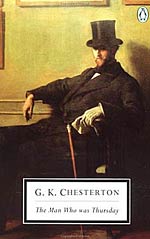
![]() verkisto
verkisto
7/26/2016
![]()
Some 20 years ago, I went to a "Haunted Trail" on Halloween. This was a thing I used to do on Halloween, and I went with a few friends of mine, as I usually did. It was fun and frightening and enticing, as a good haunted trail should be, but then, at the end of said trail, we were treated to a ten-minute sermon about Hell being the true horror, since we were all sinners and would wind up there without being saved. I didn't realize that the trail was run by a church, and it was a disappointing end to an otherwise fun night.
The reason I bring this up now is because The Man Who Was Thursday is kind of like that night. The story is tight and engaging (and I won't lie; that surprised me, given that this book was originally published in 1908), and there's a real sense of tension that builds up over the course of the novel. It starts off with two poets arguing the nature of poetry -- is it order or anarchy? -- and then develops into a full-blown plot of trying to uncover the secrets of a secret anarchistic society. Behind the secret society is the enigmatic Sunday, and the novel is about the other members of the society, Monday through Saturday, trying to figure out who he is. I don't want to spoil the plot for anyone who wants to enjoy the story for the story (because, honestly, it's really good), but the ending was disappointing, for the same reasons that haunted trail was disappointing to me so long ago.
Chesterton makes the book an allegory for Christian faith, with Sunday being God, the six other members of the society his archangels, and the original anarchist Satan. The allegory works, but as far as the story went, I wanted something a little more fitting to the story itself. It might be because I'm atheist, and that using this allegory to wrap up the secrets of an otherwise engaging story just doesn't float well with me. I seem to recall reading something about Tolkien and C.S. Lewis communicating while writing their Middle Earth and Narnia chronicles, and Tolkien criticizing Lewis for making his allegories too heavy-handed. At the time, I had never recognized The Lord of the Rings as a Christian allegory, though it was hard to miss in Lewis' series. So I wish The Man Who Was Thursday had embraced more the idea of a subtle allegory instead of making it the entire point of the story. I shouldn't have been too surprised, though, since when I was researching this title to find a copy to read, I found the story included in G.K. Chesterton''s Christian Writing.
Given that the story was originally published in 1908, the book suffers a bit for having a narrative style that feels dated. At the start of the book, we see two characters meet, and there's no exposition for how they got there, no real reason for them to encounter each other, and no introspective moments where we can understand what they represent. Instead, the meeting is told as if from a distance, maybe from the top of a nearby building. Once the story gets underway, it becomes less of an issue, but whenever another character is introduced, we meet them in this fashion.
This particular printing of the book is a print-on-demand title, meaning that the dimensions are more like for an art book than for a novel, and the print is tiny and small on the page. I can't fault the story at all for that sort of thing, but I wouldn't recommend getting this edition for casual reading. It does make me wonder, though, why these smaller presses can't figure out how to properly typeset a novel for ease of reading.
Overall, I did like the book, and I would like it a lot more if it had given a better explanation for the ending. As I mentioned, it's a tightly woven, tense detective story that's well worth reading. It's enough to make me want to look more into the Father Brown stories, that's for sure.